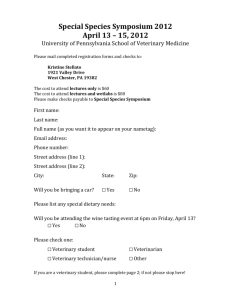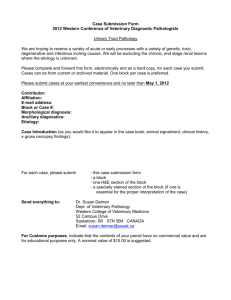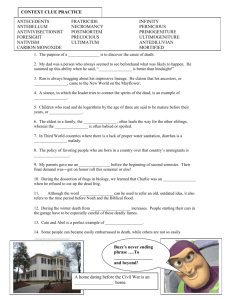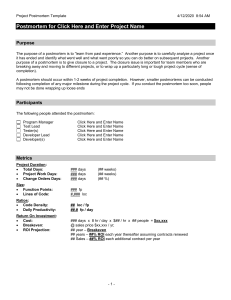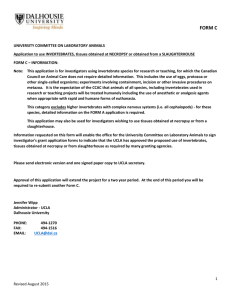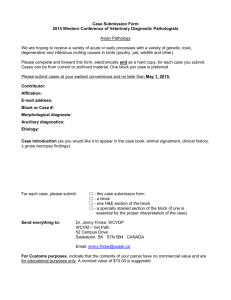ARCI-011-030 C Postmortem Exams
advertisement
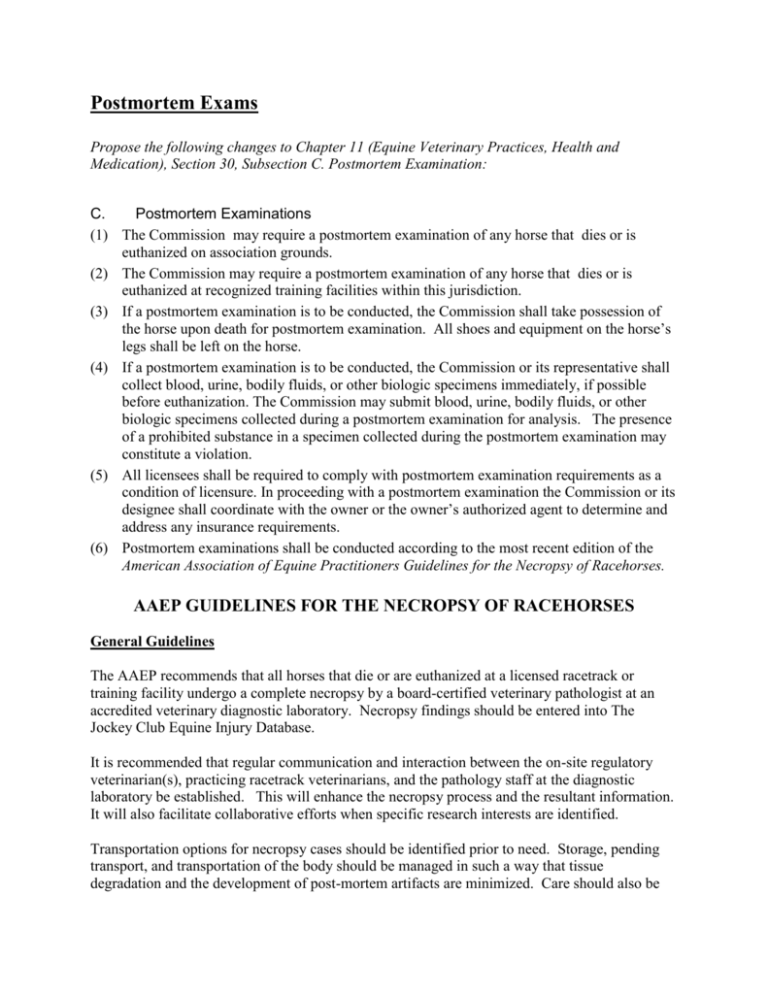
Postmortem Exams Propose the following changes to Chapter 11 (Equine Veterinary Practices, Health and Medication), Section 30, Subsection C. Postmortem Examination: C. Postmortem Examinations (1) The Commission may require a postmortem examination of any horse that dies or is euthanized on association grounds. (2) The Commission may require a postmortem examination of any horse that dies or is euthanized at recognized training facilities within this jurisdiction. (3) If a postmortem examination is to be conducted, the Commission shall take possession of the horse upon death for postmortem examination. All shoes and equipment on the horse’s legs shall be left on the horse. (4) If a postmortem examination is to be conducted, the Commission or its representative shall collect blood, urine, bodily fluids, or other biologic specimens immediately, if possible before euthanization. The Commission may submit blood, urine, bodily fluids, or other biologic specimens collected during a postmortem examination for analysis. The presence of a prohibited substance in a specimen collected during the postmortem examination may constitute a violation. (5) All licensees shall be required to comply with postmortem examination requirements as a condition of licensure. In proceeding with a postmortem examination the Commission or its designee shall coordinate with the owner or the owner’s authorized agent to determine and address any insurance requirements. (6) Postmortem examinations shall be conducted according to the most recent edition of the American Association of Equine Practitioners Guidelines for the Necropsy of Racehorses. AAEP GUIDELINES FOR THE NECROPSY OF RACEHORSES General Guidelines The AAEP recommends that all horses that die or are euthanized at a licensed racetrack or training facility undergo a complete necropsy by a board-certified veterinary pathologist at an accredited veterinary diagnostic laboratory. Necropsy findings should be entered into The Jockey Club Equine Injury Database. It is recommended that regular communication and interaction between the on-site regulatory veterinarian(s), practicing racetrack veterinarians, and the pathology staff at the diagnostic laboratory be established. This will enhance the necropsy process and the resultant information. It will also facilitate collaborative efforts when specific research interests are identified. Transportation options for necropsy cases should be identified prior to need. Storage, pending transport, and transportation of the body should be managed in such a way that tissue degradation and the development of post-mortem artifacts are minimized. Care should also be taken to employ good infection control practices with respect to equine infectious and/or zoonotic disease. If time or distance constraints preclude the transport of a deceased horse to the veterinary diagnostic laboratory, a field necropsy is recommended. Field Necropsy It is recommended for racetracks where field necropsy must be performed that a dedicated facility be available for performing necropsies. This facility should be located in a secluded area and be enclosed and covered for both privacy and protection from the elements. (A temperaturecontrolled environment is recommended in areas where extreme weather conditions may exist.) Facility design should allow an equine ambulance to drive through. The enclosure should contain a large, well-drained concrete or asphalt slab with a rough finish providing adequate traction. Ample hot and cold water supply and hose are required to clean the area. Disinfection and/or sanitization protocols should be employed following each necropsy. Field necropsy requires advance communication with carcass removal companies to determine requirements to insure that necropsied remains can be removed. Carcass removal and disposal should be performed by a licensed animal disposal company and in compliance with local, state, and federal regulations. Regulatory veterinarians are encouraged to seek guidance from veterinary pathologists to establish field necropsy protocols. Minimum standards for field necropsy are as follows: For appendicular injuries, the affected limb at the site of the injury should undergo gross dissection (+/- diagnostic imaging, toxicology, histopathology) and appropriate documentation of findings (written description and photography). The necropsy report should include identification of the affected anatomical structure(s) including a description of gross lesions found in bones, joints, ligaments, tendons, skin and blood vessels. For non-appendicular conditions, reasonable effort should be made to determine and document the cause of death. For sudden death occurring during or immediately after a race, the cardiovascular and respiratory systems warrant as comprehensive an examination as is possible. Race-related Fatalities For race-related fatalities, a ‘best practice’ inquest protocol is recommended that incorporates ante-mortem information (examples include: interviews with personnel relevant to the horse and/or the incident, exercise history, race replay video, medical history) and post-mortem findings. Ante- or immediately post-mortem blood samples (and urine, when available) should be collected, maintained under chain of custody protocols, and submitted to the official racing laboratory. Approved by the AAEP Board of Directors, August 2009.
